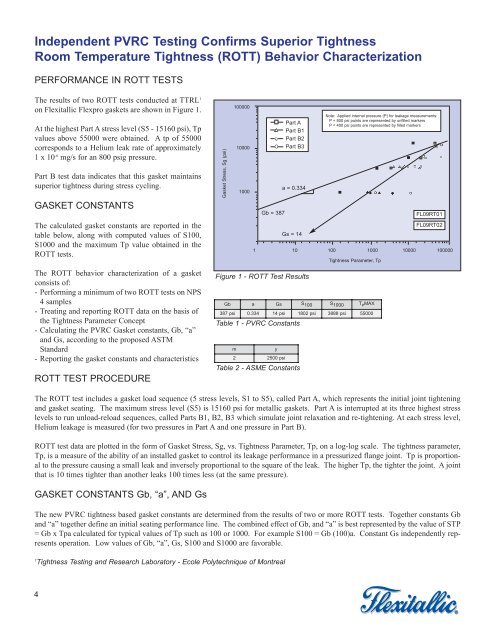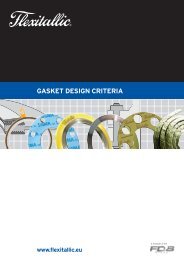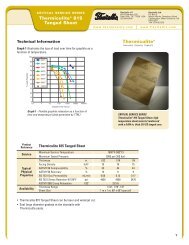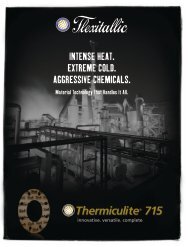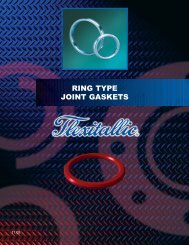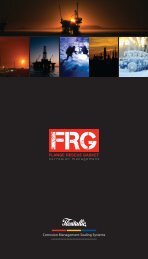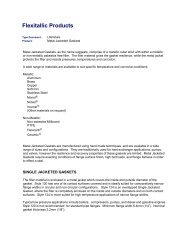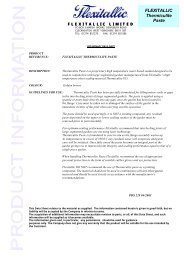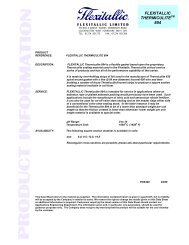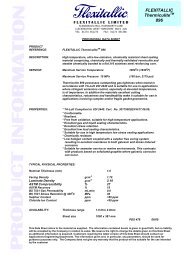Datasheet download - Induseal Gaskets GmbH
Datasheet download - Induseal Gaskets GmbH
Datasheet download - Induseal Gaskets GmbH
Create successful ePaper yourself
Turn your PDF publications into a flip-book with our unique Google optimized e-Paper software.
Independent PVRC Testing Confirms Superior Tightness<br />
Room Temperature Tightness (ROTT) Behavior Characterization<br />
PERFORMANCE IN ROTT TESTS<br />
The results of two ROTT tests conducted at TTRL 1<br />
on Flexitallic Flexpro gaskets are shown in Figure 1.<br />
At the highest Part A stress level (S5 - 15160 psi), Tp<br />
values above 55000 were obtained. A tp of 55000<br />
corresponds to a Helium leak rate of approximately<br />
1 x 10 -6 mg/s for an 800 psig pressure.<br />
Part B test data indicates that this gasket maintains<br />
superior tightness during stress cycling.<br />
GASKET CONSTANTS<br />
The calculated gasket constants are reported in the<br />
table below, along with computed values of S100,<br />
S1000 and the maximum Tp value obtained in the<br />
ROTT tests.<br />
The ROTT behavior characterization of a gasket<br />
consists of:<br />
- Performing a minimum of two ROTT tests on NPS<br />
4 samples<br />
- Treating and reporting ROTT data on the basis of<br />
the Tightness Parameter Concept<br />
- Calculating the PVRC Gasket constants, Gb, “a”<br />
and Gs, according to the proposed ASTM<br />
Standard<br />
- Reporting the gasket constants and characteristics<br />
ROTT TEST PROCEDURE<br />
The ROTT test includes a gasket load sequence (5 stress levels, S1 to S5), called Part A, which represents the initial joint tightening<br />
and gasket seating. The maximum stress level (S5) is 15160 psi for metallic gaskets. Part A is interrupted at its three highest stress<br />
levels to run unload-reload sequences, called Parts B1, B2, B3 which simulate joint relaxation and re-tightening. At each stress level,<br />
Helium leakage is measured (for two pressures in Part A and one pressure in Part B).<br />
ROTT test data are plotted in the form of Gasket Stress, Sg, vs. Tightness Parameter, Tp, on a log-log scale. The tightness parameter,<br />
Tp, is a measure of the ability of an installed gasket to control its leakage performance in a pressurized flange joint. Tp is proportional<br />
to the pressure causing a small leak and inversely proportional to the square of the leak. The higher Tp, the tighter the joint. A joint<br />
that is 10 times tighter than another leaks 100 times less (at the same pressure).<br />
GASKET CONSTANTS Gb, “a”, AND Gs<br />
The new PVRC tightness based gasket constants are determined from the results of two or more ROTT tests. Together constants Gb<br />
and “a” together define an initial seating performance line. The combined effect of Gb, and “a” is best represented by the value of STP<br />
= Gb x Tpa calculated for typical values of Tp such as 100 or 1000. For example S100 = Gb (100)a. Constant Gs independently represents<br />
operation. Low values of Gb, “a”, Gs, S100 and S1000 are favorable.<br />
1 Tightness Testing and Research Laboratory - Ecole Polytechnique of Montreal<br />
4<br />
Gasket Stress, Sg (psi)<br />
100000<br />
10000<br />
1000<br />
Gb = 387<br />
Part A<br />
Part B1<br />
Part B2<br />
Part B3<br />
a = 0.334<br />
Gs = 14<br />
Note: Applied internal pressure (P) for leakage measurements:<br />
P = 800 psi points are represented by unfilled markers<br />
P = 400 psi points are represented by filled markers<br />
FL09RT01<br />
FL09RT02<br />
1 10 100 1000 10000 100000<br />
Figure 1 - ROTT Test Results<br />
Table 1 - PVRC Constants<br />
m y<br />
2 2500 psi<br />
Table 2 - ASME Constants<br />
Tightness Parameter, Tp<br />
Gb a Gs S 100 S 1000 T P MAX<br />
387 psi 0.334 14 psi 1802 psi 3888 psi 55000<br />
®


